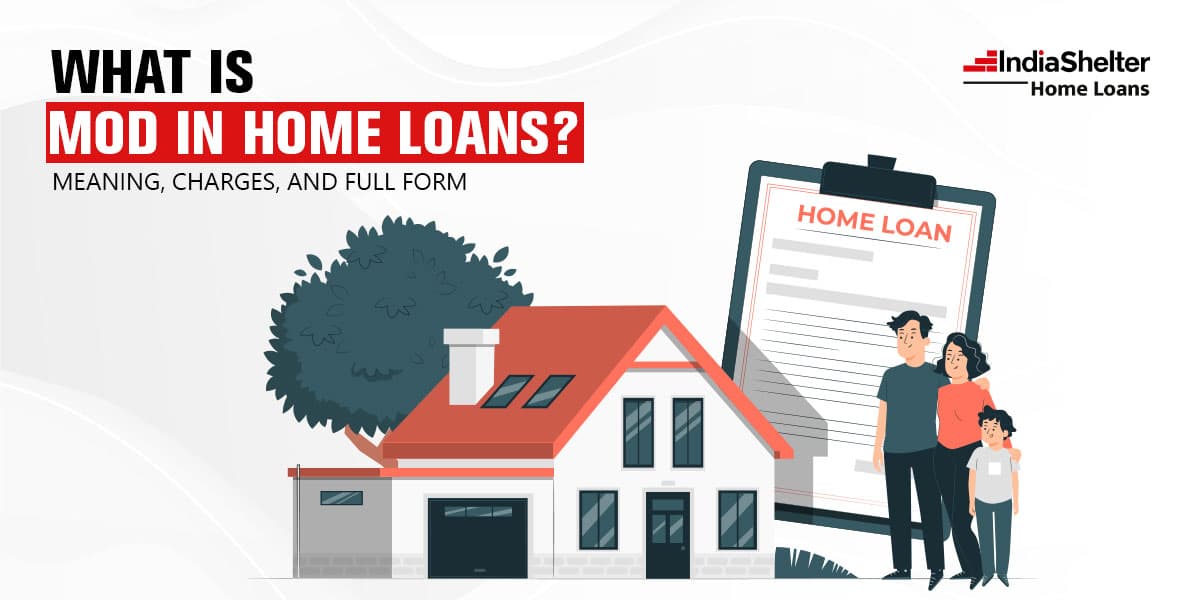What is MOD in Home Loans: Meaning, Charges, and Full Form

Published on :2025-01-09
When you apply for a home loan with any financial organisation, be it a bank or an NBFC (non-banking financial company), they will definitely ask you to furnish a few documents, like identity proof, address proof, income documents, and property documents. Submitting these documents is an integral and important part of the loan approval and sanction process. They require these papers to verify the details you mention in the loan application.
Apart from submitting these documents, the lender may also require you to sign a few undertakings, including the MOD. If you are a first-time loan applicant and not sure what is MOD, then the guide is just for you.
What is MOD in home loan?
MOD full form in home loan, is a Memorandum of Deposit. It is a legal document drawn and executed by the lending organisation and signed by both the lender and the borrower (you). It serves as a record of the asset that you have offered as collateral to the lender. In that regard, the asset is the property that you wish to buy and get the loan for.
Typically, financial organisations finalise the memorandum of deposit when they disburse the sanctioned loan amount or release the final loan instalment into your account.
How does the MOD protect the borrower’s interest?
When you avail a home loan, you borrow a substantial amount. The lender grants the loan with set terms and conditions and draws the MOD. While the lenders benefit from the MOD, it also protects the interest of the borrowers.
So, when you avail of the loan, the MOD legally and formally documents the nature of the relationship between you and the lender, as well as lists important terms and conditions. For example, the MOD clearly spells out under what circumstances the lender can ask you to provide any additional collateral or make part payments.
Similarly, the MOD in home loan also lays down the circumstances under which the lender can repossess your property. Typically, the process flow for taking over the property includes sending a legal notice about the non-payment of the EMIs, giving a notice period, a cooling period and then auctioning off the property.
Additionally, the MOD also lists how the lender must return all the property-related documents, including the property title deed, the NOC (No Objection Certificate), and other link documents, to you after you have fully repaid the borrowed amount. If the lender delays returning the property papers, you can use MOD as a guiding document to get back the papers.
What are the charges associated with MOD?
Now that you know what MOD is in home loan, you must also know about the charges associated with it. As a borrower, you must know that signing the MOD involves a significant fee. This is an addition to the processing charges.
The home loan MOD charges you pay may vary from one lender to another. However, it usually ranges from 0.1% to 0.5% of the total sanctioned loan amount. Some lenders may charge the MOD fee as part of the loan processing fees, and a few others charge it separately.
Typically, the breakdown of the MOD charges levied by the lender includes administrative expenses relating to the creation, maintenance, and registration of the MOD document. As a home loan borrower, you must be fully aware of these charges to make informed decisions and have a smooth borrowing journey.
How to cancel the MOD?
After you repay the final EMI of the home loan or prepay the amount, it is your responsibility as a borrower to cancel the MOD and take full ownership of the property. When you ask the lender to give back your property papers, they will retrieve the release deed from the registration office and instruct the registration department to cancel the MOD.
To cancel the MOD from the lender, you must follow the below steps:
- First and foremost, after you have repaid the loan, you must get an NOC from the lender. The NOC must contain all the necessary details, including the amount you borrowed, the amount you repaid, the date of your last EMI Payment, etc. Please note that you can withdraw the MOD only after the lender has cleared you of all dues on your home loan.
- Once you get the NOC, you must request the lender to provide you with the deep receipt.
- Finally, you must visit the sub registrar's office, submit the NOC and deed receipt, withdraw the MOD, and ask the registrar to remove the lien on the property.
You can also cancel the MOD online. For this, you must follow the below steps:
- First, visit the lender's official website and click on the 'deed of receipt' option or any other link to the MOD.
- You may be required to fill out a form and provide a few basic personal and loan details
- Some of the lenders would require you to make a payment. It is usually a nominal amount ranging from Rs. 200 to Rs. 500.
- Once you make the payment, you must schedule an appointment with the registrar.
- On the day of the appointment with the registrar, a representative from the registrar’s office will conduct a preliminary review of your loan details and tag the documents as reviewed.
- Next, the documents will be sent to the registrar, who will review the bank's credentials before approving them.
- After getting the registrar's approval, you must proceed to get a fingerprint scan and photograph. At this stage, a representative from the registrar's office will verify whether the payment is done.
- Finally, you can submit a copy of the receipt for payment and the deed of receipt.
Conclusion
As a home loan borrower, a MOD is critical, and you must understand its significance. This will help you navigate the complexities of the home loan. Knowing the legal obligations relating to a home loan MOD can help you make an informed borrowing decision.
Related Blogs

2025-12-11
Common Mistakes to Avoid When Applying for a Home Loan in 2026
Planning to take a home loan in 2026? Don’t apply before reading this- learn about the top mistakes many borrowers make and how you can avoid them for smoother approval and lower long-term costs.

2025-07-30
How Green Homes Can Cut Your Electricity Bills by Up to 40%
Discover how simple eco-friendly changes in your home can reduce electricity bills by up to 40% and lower your carbon footprint. Start your green journey today!

2025-07-30
How Much Home Loan Can I Get with a ₹25,000 Monthly Salary?
Wondering how much home loan you can get on a ₹25,000 monthly salary? Find out your eligibility, loan amount, and smart tips to improve approval chances.
Disclaimer: *By contacting IndiaShelter on Toll Free/WhatsApp/Website or any other mode, you authorize our representatives to reach out to you through personal communication via SMS, WhatsApp and phone calls regarding our services. This consent will supersede any registration for any Do Not Call (DNC) / National Do Not Call (NDNC).
© India Shelter Finance Corporation 2024 | All rights reserved
Design with byCyberworx





